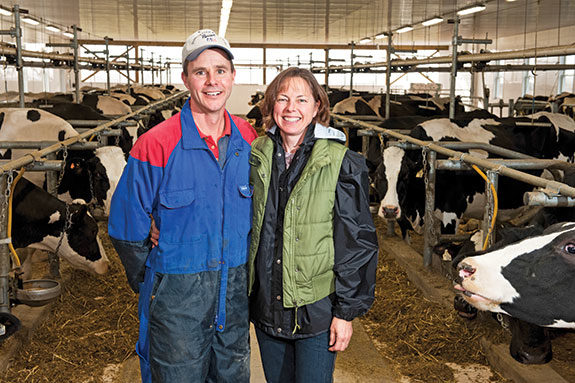Thom Mueller, the 2012 winner of the Ontario Forage Masters Program, grew up in a small town just outside of Ottawa, Canada. His parents, who are now semi-retired, worked hard to build a foundation for the family farm where he now lives with his wife, Wilma, and two daughters, Mikaela and Cassy.
They milk about 85 cows in a tiestall barn and work about 450 acres of land to feed the growing herd at Gruen Valley Farm Ltd.

For the Muellers, doing their best means striving to do little things in an efficient, profitable manner. In order to accomplish this, they have built a group of strong resources.
Thom realizes there is no way they can do everything by themselves, so they have to rely on each member of their team.
Thom recently gave a presentation during the American Forage and Grassland Council conference and competed in the Forage Spokesperson contest.
He stated, “My team is a group of consultants who help ensure positive results using forage. The most important member of my team is my wife, Wilma.”

Another key member of the team is their agronomist. “Paul (their agronomist) uses summer students to scout my fields during the growing season.
There is always something we need to discuss during the busy growing season. He soil samples my fields every two to three years.
This year, because of the stress on alfalfa, and taking four cuts on the established fields and three on the new seedlings, he noticed we were low on potash.
By working with a crop consultant, I have been able to maintain and improve the fertility on my farm,” Mueller said. They also keep records for manure use and what crops will be rotated from year-to-year.
Crop rotation is an important management principle at Gruen Valley Farm. “[Crop rotation] allows us to maintain soil quality and improve soil health in terms of stability and soil drainage. Forages in the rotation help to keep weeds in check and limit soil erosion,” stated Mueller.

“The deep roots of alfalfa help improve organic matter levels and soil structure. A hay yield of three-and-a-half tons is similar to 160 bushels of corn crop on the same acre.”
They work about 450 acres of land. There are 140 acres of forages, 150 acres of corn, 95 acres of soybeans and 60 acres of wheat.
Alfalfa stays in rotation for about 11 cuts of three years and then it is rotated out.
For establishing alfalfa, Mueller knows it is critical to get a good seedbed in order to get the crop started right.
“We typically sow at a rate of 10 to 12 pounds of certified seed alfalfa per acre blended with two to three pounds of timothy grass and five to six pounds of reed canarygrass. The mixture is drilled at ¼-inch depth,” said Mueller.
The next member of the team, also named Paul, is their nutritionist. “We have a close working relationship both on the farm and on the golf course,” says Mueller. “He uses all of our forages to create a balanced ration at the least cost to us.

We try to make it easy for him by being consistent in our cutting time. I strive for 20 percent crude protein (CP), 30 percent ADF and 40 percent NDF.
This year, however, was really tough because of the lack of rain and the wide variability in the fields.”
By putting in a balanced TMR, both Mueller and his nutritionist can make the most out of the forages and create the greatest ROF, return over feed.
Mueller states, “What drives return over feed starts in the field. Harvesting forages at the proper moisture content and making sure it is well-fermented drives dry matter intake, which drives production, which drives the bottom line.
“At harvest time, we shoot for the pre-bud stage of the alfalfa because this keeps our forages at their highest quality.
If the alfalfa starts pushing beyond knee-height, I know it is time to cut. In our area, it typically means cutting at 30-day to 35-day intervals. This gives us our four cuts during our shorter summer growing season.
“I check the weather and if things look good, I immediately call the custom harvesters and get them lined up for harvesting. We harvest in a wide windrow (our custom harvesters have a 30-foot head).
This allows us to keep things at optimal moisture by laying things flat and letting them dry.
“When we put it in the bag, we use an inoculant to help reduce dry matter losses.

This also keeps the sugar levels up, which increases the palatability of the forages.
We try to keep a consistent stretch on the plastic combined with a consistent fill rate.
This ensures the feed is properly packed. Our bagging system allows us to separate out the different cuttings to achieve consistency in each.”
One example of their commitment to forages is centered around the fact that they used to make 10,000 to 12,000 small square bales of hay, taking all summer to do so. Now they cut and harvest about 120 acres of forages in two days.

Other things they have done to improve their farm include adding on to the barns in order to milk more cows and installing a robotic feeder to get their calves off to a good start.
They added an irrigation system to their manure collection facilities to be able to spread the manure in a more timely manner. And they also built an Ag-Bag system to store forage in order to get it up out of the mud and decrease spoilage.
The other side of why Mueller Farms cares about doing their best is to remain profitable. “To help achieve consistent economic results, we maximize our use of homegrown forages.
But at the end of the day, it is the dollars per cow that most affects our bottom line,” said Mueller.
Another important member of their team is their veterinarian, Willie. Mueller states, “He works with the health and reproduction of my cows and serves as another pair of eyes to make sure I stay on top of things.
“By getting our calves started out right in the calf barn, we can add to their value by giving them a balanced TMR based on using quality forages. We are able to start breeding our heifers at 12 to 13 months, which results in bigger returns.”
The Mueller family understands that forages are the foundation behind dairy rations and that forage quality affects herd health and production performance.
“A high level of production is reached by putting our focus on growing and producing top-quality forages,” states Mueller. “We strive to achieve higher quality and consistency each year by reviewing and implementing the things that work well for us.
“The beauty of forages is that their method of harvest and storage can adapt to the growing pace and changes we need for our growing operation,” said Mueller. FG
PHOTOS
PHOTO 1: Thom Mueller and his wife, Wilma, milk 85 cows on their farm near Ottawa, Canada.
PHOTO 2: After graduating from the University of Guelph with a bachelor’s in agribusiness, Thom returned home to take over the family farm, which is spread out over 450 acres.
PHOTO 3: Their bagging system allows them to separate out different cuttings to achieve a high level of consistency to use in formulating the dairy rations.PHOTO 4: The Muellers employ custom harvesters that have a 30-foot head on their mower to spread forage out in wide windrows to lay flat as they dry to help them achieve optimal moisture levels.
PHOTO 5: At harvest time, they shoot for the pre-bud stage of the alfalfa because this keeps the forages at their highest quality. If the alfalfa starts pushing beyond knee-height, it is time to cut.
PHOTO 6: The Mueller family understands that forages are the foundation behind dairy rations and that forage quality affects herd health and production performance.
PHOTO 7: Dairy cows on the farm reach high levels of production because of the Muellers’ focus on growing and producing top-quality forages. They strive to achieve higher quality each year by reviewing and implementing the things that work well. Photos courtesy of Thom Mueller.













